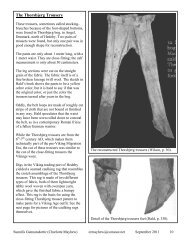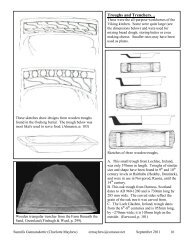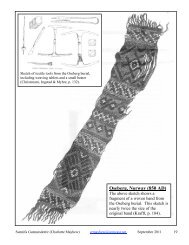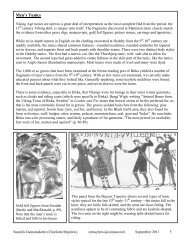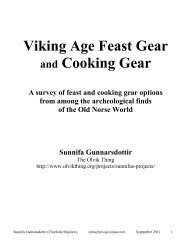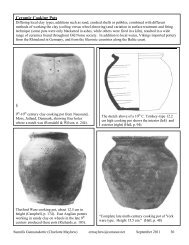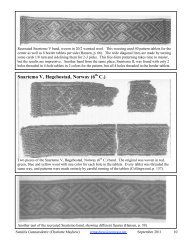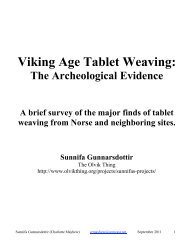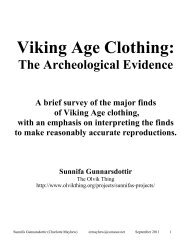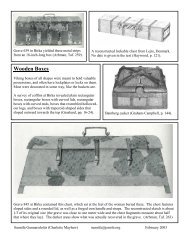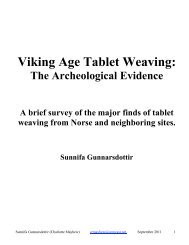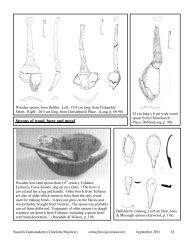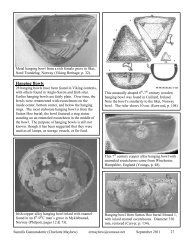Create successful ePaper yourself
Turn your PDF publications into a flip-book with our unique Google optimized e-Paper software.
<strong>Feast</strong> <strong>Gear</strong><strong>and</strong> <strong>Cooking</strong> <strong>Gear</strong>for yourViking Age PersonaA survey of feast <strong>and</strong> cooking gear optionsfrom among the archeological findsof the Old Norse WorldSunnifa GunnarsdottirThe <strong>Olvik</strong> <strong>Thing</strong>http://www.olvikthing.org/projects/sunnifas-projects/Sunnifa Gunnarsdottir (Charlotte Mayhew) crmayhew@comcast.net September 2011 1
Viking Age <strong>Feast</strong> <strong>Gear</strong> - Table of Contents3 Notes4 Wooden Lathe-Turned Cups <strong>and</strong> Bowls5-6 Silver Cups <strong>and</strong> Horn Mounts (2 pages)7-9 Glass Drinking Vessels from Birka10 Ceramic Cups <strong>and</strong> Pitchers11-12 Wooden Bowls (2 pages)13-14 Silver Bowls (2 pages)15 Metal Bowls from Gotl<strong>and</strong>16 Troughs <strong>and</strong> Trenchers17 <strong>and</strong> Plates18-22 Spoons (5 pages)23 Spoon Boxes24-26 Knives (3 pages)27 Hanging Bowls28-29 Soapstone Bowls (2 pages)30-34 Ceramic <strong>Cooking</strong> Pots (5 pages)35 Special Vessels for Wine <strong>and</strong> Mead36-37 <strong>Cooking</strong> Tools38-39 Oseberg Cauldron & Tripod40 Sc<strong>and</strong>inavian Trade Routes41-43 Bibliography (3 pages)Sunnifa Gunnarsdottir (Charlotte Mayhew) crmayhew@comcast.net September 2011 2
A Few Notes about the Old Norse WorldFor the purposes of this presentation, the words Viking, Norse <strong>and</strong> Old Norse are used interchangeably.The Viking Age is defined as the period of raiding <strong>and</strong> exploration for which the Vikings are most famous.It begins officially in June, AD 793 with the attack on the monastery at Lindisfarne in Scotl<strong>and</strong>.It ends in September, AD 1066 with the death of Harald Hardrada at the Battle of Stamford Bridge (a merethree weeks before William the Conqueror invaded Engl<strong>and</strong> <strong>and</strong> defeated Harold Godwinson at Hastings).It should be noted that the various groups of people who spoke Old Norse did not consider themselves to bethe same; history has lumped them together.The Old Norse World covers a vast geographical area. In addition to Sc<strong>and</strong>inavia (modern Norway, Sweden,Finl<strong>and</strong> <strong>and</strong> Denmark), the Vikings had colonies strung across the Atlantic Ocean in Icel<strong>and</strong>, Greenl<strong>and</strong> <strong>and</strong>briefly at the L’Anse aux Meadows site in Newfoundl<strong>and</strong>, Canada. Danes invaded large parts of Engl<strong>and</strong>; forsome 60 years, they had their central seat in the town of Jorvik (modern-day York, Engl<strong>and</strong>). Most cities inIrel<strong>and</strong> started out as Viking strongholds; their center was in modern-day Dublin. In addition, Viking traderstraveled along the major rivers in what is now modern-day Russia (the Rus was originally another name forNorse tribes) all the way to Byzantium (modern day Turkey). Along this trade route, Viking traders settled<strong>and</strong> married into the local populations. Digs at Staraja Ladoga, Novgorod <strong>and</strong> Kiev have yielded interestingfinds.Regional differences between these peoples can be seen in their cooking <strong>and</strong> eating utensils. The availablenatural resources drive the choice of materials for eating <strong>and</strong> cooking utensils. Poor Viking households usedwhatever was available, from wood to soapstone or steatite to volcanic tuff. More wealthy Vikings usedimported (or looted) silver-gilt cups, glass beakers or pottery decorated with silver strips from the Rhinel<strong>and</strong>in Germany. Several examples of both of these have been unearthed in the large Viking trading port of Birka.Wood was far more commonly used than pottery, glass or metal for tableware, but fewer examples havesurvived the centuries. Wooden items simply do not survive in graves through the centuries as well as othermaterials. Broken wooden items were most likely disposed of in the fire. I believe it is safe to assume thatmost Vikings had many more wooden items than the grave finds would lead us to believe.“Soapstone, or steatite, is a compact form of talc, a magnesium-silicate mineral. Veins of soapstone arecommon in Norway, Western Sweden <strong>and</strong> the Shetl<strong>and</strong> Isl<strong>and</strong>s, where they were extensively exploited in theViking Age. . . . Soapstone vessels were exported throughout Sc<strong>and</strong>inavia <strong>and</strong> Sc<strong>and</strong>inavian-settled areas tothe west, where they were preferred to pottery for cooking because they were tough, easy to clean, distributedheat well <strong>and</strong> did not taint the flavor of food as unglazed pottery can. Soapstone bowls were also exported toPol<strong>and</strong> <strong>and</strong> Germany.” (Haywood, pp. 179-180)“Pottery was little used in Viking Age Sc<strong>and</strong>inavia: only at the Danish town of Hedeby has evidence of largescalepottery manufacture been identified. Soapstone pots were generally preferred for cooking, <strong>and</strong> woodenvessels were widely used for storage. The potter’s wheel was not used in Sc<strong>and</strong>inavia until c. 1200, so mostpottery was made crudely by h<strong>and</strong>, usually by building up the vessel from coils of clay. The clay wastempered by grit, which often protrudes, giving the pots an uneven surface. Pottery was usually fired at lowtemperatures on a fire or in an earth clamp. A variety of regional styles are known; decoration, if there is any,is simple. Round-bottomed vessels were preferred in Jutl<strong>and</strong>; flat-bottomed, elsewhere in Sc<strong>and</strong>inavia. After1000, Slav-inspired pottery styles became popular in Sc<strong>and</strong>inavia. Fine-quality pottery was imported intoSc<strong>and</strong>inavia from the Rhinel<strong>and</strong> throughout the Viking Age.” (Haywood, p. 151)Sunnifa Gunnarsdottir (Charlotte Mayhew) crmayhew@comcast.net September 2011 3



